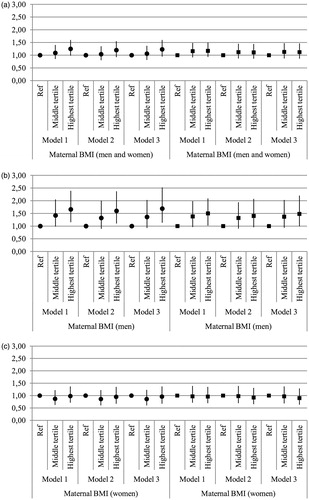Figures & data
Figure 1. (a) Odds ratio (OR) and 95% confidence intervals (CI) for poor physical functioning (dots) and psychosocial functioning (squares) according to tertiles of maternal body mass index, both sexes combined. Model 1 is adjusted for age and sex; Model 2, in addition to age, is also adjusted for parity, gestational age, childhood social class and smoking; Model 3, in addition to all previous adjustments, is adjusted for birth weight. (b) Odds ratio (OR) and 95% confidence intervals (CI) for poor physical functioning (dots) and psychosocial functioning (squares) according to tertiles of maternal body mass index for men. Model 1 is adjusted for age; Model 2, in addition to age, is also adjusted for parity, gestational age, childhood social class and smoking; Model 3, in addition to all previous adjustments, is adjusted for birth weight. (c) Odds ratio (OR) and 95% confidence intervals (CI) for poor physical functioning (dots) and psychosocial functioning (squares) according to tertiles of maternal body mass index for women. Model 1 is adjusted for age; Model 2, in addition to age, is also adjusted for parity, gestational age, childhood social class and smoking; Model 3, in addition to all previous adjustments, is adjusted for birth weight.

Table 1. Maternal characteristics of men and women belonging to the Helsinki Birth Cohort Study.
Table 2. Odds ratio (OR) and 95% confidence intervals (95% CI) for poorer physical and psychosocial functioning according to thirds of offspring birth weight.
